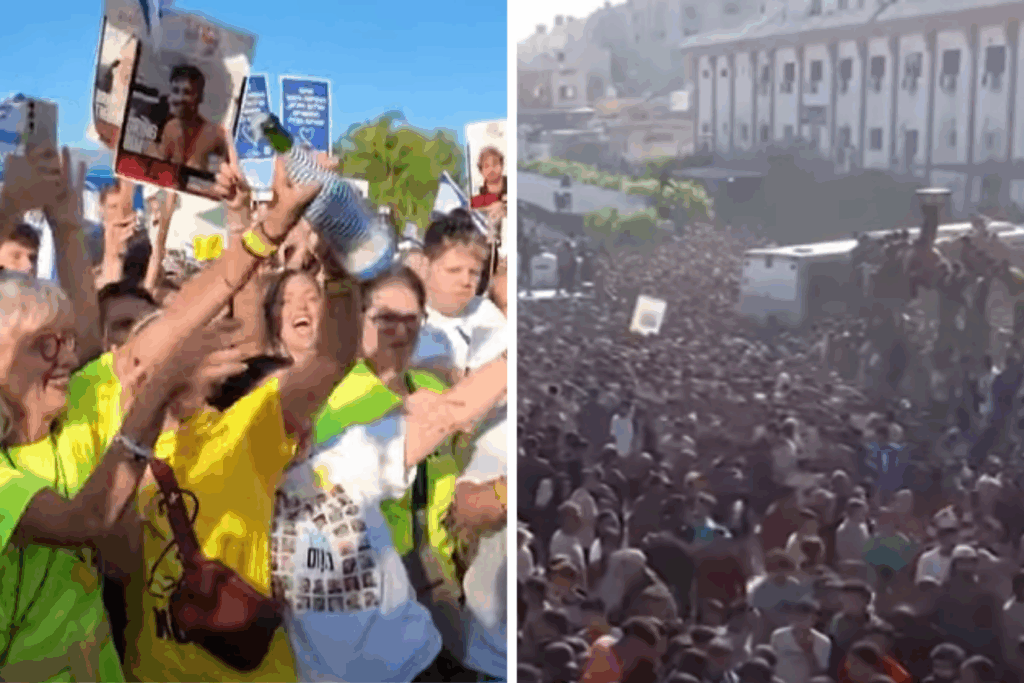Families and loved ones have been reunited in emotional scenes following a breakthrough Gaza ceasefire deal that has seen hostages and prisoners released.
On Monday, all 20 living Israeli hostages still held by Hamas in Gaza were released after more than two years in exchange for Israel’s release of nearly 2,000 Palestinian prisoners.
The release of the Israeli hostages began at around 8am local time, with the first seven transferred by Hamas into the care of the Red Cross, before the Israeli Defence Force gathered them. The remaining 13 surviving hostages were delivered shortly after.
The remains of the other deceased Israeli hostages are expected to be sent to the national Institute of Forensic Medicine for identification.
Tens of thousands of Israelis watched the transfers of the hostages at public screenings across the country, with a major event held in Tel Aviv.
“It’s so exciting and overwhelming that it’s finally happening, that what we’ve been fighting for for over two years, finally our hostages are coming home,” Shelly Bar Nir told AFP News while waiting for the hostages in Tel Aviv.
Israel released nearly 2,000 Palestinian prisoners as part of the Gaza ceasefire deal, with crowds gathering in the West Bank city of Ramallah to welcome them home.
Thousands of Palestinian families gathered to be reunited with their relatives, some of whom had spent decades in prison.
While some families were able to embrace their loved ones at the Ramallah Cultural Centre, where the prisoners were released, others were shocked to hear that some of the prisoners on the list to be freed, would not be there.
According to the Palestinian Prisoners’ Media Office, Israel decided to exile 154 out of 250 Palestinian political prisoners it released. These men are expected to be taken to other countries and face constraints on their movements.
Tamer Qarmout, associate professor in public policy at the Doha Institute for Graduate Studies, told Al Jazeera that the exile orders amount to forced displacement of these individuals, and that the prisoners’ families may never see them again as Israel makes it hard for Palestinians to travel outside Palestine.
The ceasefire in the two-year Israel-Hamas war is the first phase of a plan brokered by US president Donald Trump’s administration.
Amid the release of hostages and prisoners, Trump visited the Middle East region, going first to Israel to address the parliament and then to Egypt for the “Summit of Peace”, where world leaders plan to discuss the ceasefire plan.
It’s been two years since Hamas-led militants attacked Israel on October 7, 2023, killing around 1,200 people and taking 251 hostages. In response, Israel has killed more than 67,600 Palestinians in Gaza, according to Gaza’s Health Ministry.
Much of Gaza is in ruins from the conflict, and humanitarian organisations have said aid is expected to surge into the territory.
In August, the world’s leading authority on food crises, the Integrated Food Security Phase Classification, said famine was devastating Gaza city, where hundreds of thousands of Palestinians live. The famine was projected to spread to the southern cities of Deir al-Balah and Khan Younis around this time if the crisis did not improve.
The Israeli defence body in charge of humanitarian aid in Gaza has said around 600 trucks of aid per day will be entering soon, under the ceasefire agreement.
Questions remain around what the ceasefire agreement will lead to, as many around the world hope it signals lasting peace for the region.
Co-director of the Palestine Institute for Public Diplomacy, Ines Abdel Razek told Al Jazeera that it’s likely many Palestinians have “mixed feelings” about the situation, as Israel’s control over the Palestinian territories is not over.



